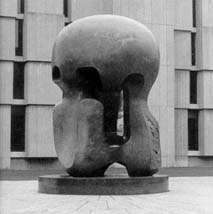Nuclear Energy (sculpture)
 | |
| Artist | Henry Moore |
|---|---|
| Year | 1967 |
| Type | Bronze |
| Dimensions | Divergent measurements exist; see text |
| Location | University of Chicago (outdoor) at the former site of the Stagg Field west stands, Chicago, Illinois |
.png)
Nuclear Energy is a bronze sculpture by Henry Moore that is located on the campus of the University of Chicago at the site of the world's first nuclear reactor, Chicago Pile-1. The first man-made self-sustaining nuclear chain reaction was initiated here on December 2, 1942.
Location
Nuclear Energy is located on Ellis Avenue, between the Max Palevsky West dormitory and the Mansueto Library in the Hyde Park community area of Chicago. The location commemorates the exact location where the Manhattan Project team devised the first nuclear reactor to produce the first self-sustaining controlled nuclear reaction under the now demolished west stands of the old Stagg Field.[1]
History
The sculpture was commissioned by the B. F. Ferguson monument fund.[2]
It’s a rather strange thing really but I’d already done the idea for this sculpture before Professor McNeill and his colleagues from the University of Chicago came to see me on Sunday morning to tell me about the whole proposition. They told me (which I’d only vaguely known) that Fermi, the Italian nuclear physicist, started or really made the first successful controlled nuclear fission in a temporary building. I think it was a squash court - a wooden building - which from the outside looked entirely unlike where a thing of such an important nature might take place. But this experiment was carried on in secret and it meant that by being successful Man was able to control this huge force for peaceful purposes as well as destructive ones. They came to me to tell me that they thought where such an important event in history took place ought to be marked and they wondered whether I would do a sculpture which would stand on the spot. (Henry Moore quoted in Art Journal, New York, spring 1973, p.286)[3]
The sculpture is described as 14.0 feet (4.3 m) in height and 8 feet (2.4 m) in diameter by the Smithsonian Institution[4] and it sits atop a base that is 1.5 feet (0.46 m) in height and 10 feet (3.0 m) in diameter.[1] However, the University of Chicago says it is only 12 feet (3.7 m) in height.[5] The Henry Moore Foundation lists its height at 3.66m.[3] The sculpture reminds some of the human skull, while it reminds others of an atomic mushroom cloud.[5]
The sculpture was erected for and dedicated at the celebration of the 25th anniversary of the initiation of the first self-sustaining controlled nuclear reaction on the grounds by Fermi on December 2, 1942. Thus, it was dedicated at precisely 3:36 p.m. on December 2, 1967.[1][2][5] The site of the first nuclear reaction received designation as a National Historic Landmark on February 18, 1965 and was added to the newly created National Register of Historic Places (NRHP) on October 15, 1966 as one of the original designated historic places.[6] Chicago Pile-1 is one of four Chicago NRHPs on the original list.[7] The site was named a Chicago Landmark on October 27, 1971.[8] Four plaques are placed on a nearby granite wall marking the site. The oldest plaque was originally placed in 1947 on the wall of the old stadium, while the other plaques mark the installation of the sculpture and the historic designations of the site.[9]
A working model for Nuclear Energy ("Atom Piece (Working Model for Nuclear Energy) 1964-65") is on display at the Hiroshima City Museum of Contemporary Art, Japan.[10]
See also
Notes
- 1 2 3 "Nuclear Energy, (sculpture).". Smithsonian Institution. Retrieved July 18, 2008.
- 1 2 Greene-Mercier, Marie Zoe (Winter 1982). "The Role of Materials in My Geometric and Abstract Sculpture: A Memoir". Leonardo. 15: 1–6. doi:10.2307/1574334. JSTOR 1574334.
- 1 2 "Henry Moore - Works in Public - Nuclear Energy 1964-66 (LH 526)". Henry-moore-fdn.co.uk. Retrieved May 4, 2010.
- ↑ "Nuclear Energy, (sculpture)". Art Inventories. Smithsonian American Art Museum. Retrieved May 3, 2014.
- 1 2 3 "Nuclear Energy". The University of Chicago Department of Physics. Archived from the original on May 20, 2008. Retrieved July 18, 2008.
- ↑ "Site of the First Self-Sustaining Nuclear Reaction". National Park Service. Retrieved July 17, 2008.
- ↑ National Park Service (2007-01-23). "National Register Information System". National Register of Historic Places. National Park Service.
- ↑ "Site of the First Self-Sustaining Controlled Nuclear Chain Reaction". City of Chicago Department of Planning and Development, Landmarks Division. Retrieved July 17, 2008.
- ↑ "Full text of 'City of Chicago Landmark Designation Reports'". Commission on Chicago Historical and Architectural Landmarks.
- ↑ "Henry Moore - Works in Public - The Arch 1963 (503b)". Henry-moore-fdn.co.uk. Retrieved May 4, 2010.
External links
Coordinates: 41°47′33″N 87°36′04″W / 41.7925°N 87.6011°W

